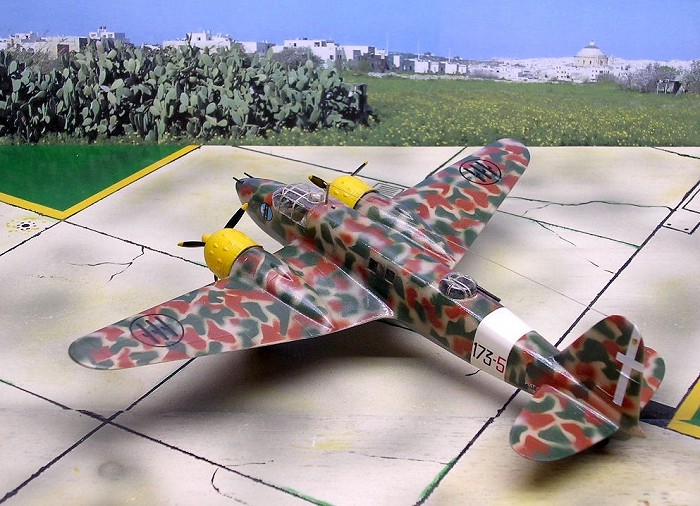
| KIT: | Airmodel 1/72 Fiat CR.25bis |
| KIT #: | AM 404 |
| PRICE: | $ |
| DECALS: | ? options |
| REVIEWER: | Carmel Attard |
| NOTES: | Vacuformed plastic with injected parts |

| HISTORY |
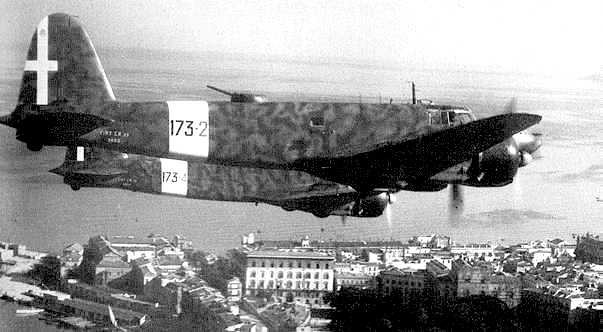
Ing.Celestino Rosaletti designed the Fiat CR25 as a multi all-purpose aircraft for use in Italy's North African territories. The CR-25 was a twin engine, three seat, long range escort fighter and reconnaissance monoplane. Bearing a marked resemblance to the BR-20 bomber of same designer it employed a two-spar, three-section wing mounted in low-mid positioned to a rectangular section welded steel tube fuselage.
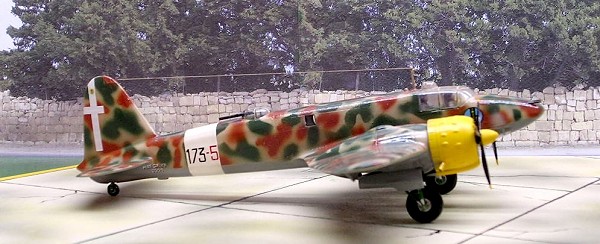 The
CR-25 first flew in 1937, and was powered by 840HP Fiat A.74 RC.38
fourteen-cylinder radial engines. Two prototypes were built followed by ten
pre-production machines, one of which was used as transport by the Italian
Air Attaché in Berlin. This was designated CR-25D. The other nine were
designated CR-25 bis and these equipped the 173 Strategic Naval
Reconnaissance Squadron. These nine aircraft formed one operational
squadron and was based in Sicily from July through October 1942. Their role
was to act as convoy escort between Sicily and the Italian peninsula. It is
known that at times this type encountered opposing RAF Beaufighters which
were on convoy strike and destroy missions from bases at ta'Qali and Hal-Luqa
on the strategic island of Malta. On occasions the CR-25 was also employed
on sneaky but very risky reconnaissance flights to Malta. This included
photographing military installations around Hal-Luqa and Hal-Far airfields,
coal dump areas at il-Menqa in Marsa, and the torpedo and Submarine Depot
at l-Imsida besides the naval installations and Dockyard facilities at the
Kottonera and Casal Paula area and other localities on the island. So
daring was their mission that some of the CA-25 found their graveyard in
the blue depth of the Mediterranean.
The
CR-25 first flew in 1937, and was powered by 840HP Fiat A.74 RC.38
fourteen-cylinder radial engines. Two prototypes were built followed by ten
pre-production machines, one of which was used as transport by the Italian
Air Attaché in Berlin. This was designated CR-25D. The other nine were
designated CR-25 bis and these equipped the 173 Strategic Naval
Reconnaissance Squadron. These nine aircraft formed one operational
squadron and was based in Sicily from July through October 1942. Their role
was to act as convoy escort between Sicily and the Italian peninsula. It is
known that at times this type encountered opposing RAF Beaufighters which
were on convoy strike and destroy missions from bases at ta'Qali and Hal-Luqa
on the strategic island of Malta. On occasions the CR-25 was also employed
on sneaky but very risky reconnaissance flights to Malta. This included
photographing military installations around Hal-Luqa and Hal-Far airfields,
coal dump areas at il-Menqa in Marsa, and the torpedo and Submarine Depot
at l-Imsida besides the naval installations and Dockyard facilities at the
Kottonera and Casal Paula area and other localities on the island. So
daring was their mission that some of the CA-25 found their graveyard in
the blue depth of the Mediterranean.
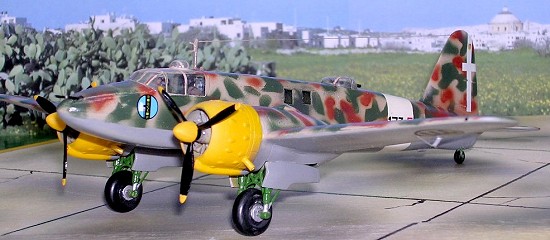 Operational strength in reality never exceeded six aircraft during the
time due to lack of spares and replacement necessitating a short
operational life for the squadron. The CR-25 bis escort fighter was fitted
with two 12.7 mm Breda-SEFAT guns in the nose and a third 12.7 mm gun in
power-operated dorsal turret. To extend its range extra fuel tanks were
fitted in the internal bomb bay, which was originally designed to
accommodate a maximum bomb load of 1550 Lbs. By October 1942, when an average
of
three machines were serviceable, the type was relegated to transport
duties.
Operational strength in reality never exceeded six aircraft during the
time due to lack of spares and replacement necessitating a short
operational life for the squadron. The CR-25 bis escort fighter was fitted
with two 12.7 mm Breda-SEFAT guns in the nose and a third 12.7 mm gun in
power-operated dorsal turret. To extend its range extra fuel tanks were
fitted in the internal bomb bay, which was originally designed to
accommodate a maximum bomb load of 1550 Lbs. By October 1942, when an average
of
three machines were serviceable, the type was relegated to transport
duties.
In 1940 work has been initiated on a more heavily armed variant, a CR-25 which also had a slight increase in wing area. However the basic CR-25 design was abandoned and further development ceased. The CR-25 had a maximum speed of 286 mph at 18,200 ft; a cruising speed of 245 mph, landing speed of 78 mph and normal range was 972 miles and a maximum range of 1305 miles. Service ceiling of 26,575 ft. Dimensions of all models were: Span 51'10", Length 44' 5.75", and Height of 11' 1.75" and a wing area of 421.8 Sq. ft.
| THE KIT |
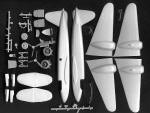 The 1/72
scale model of the CR-25 bis made by Airmodel of Germany is kit NoAM-404
and comes in a box of reasonably strong cardboard with a painting depicting
a twin formation of the aircraft in flight. The box art is basically black
and yellow but is very striking on first sight as it exposes all the CR-25
characteristic design. Upon opening the box you will find a single
injection moulded sprue having eight runner bars to which are attached no
less then 28 injection moulded highly detailed parts in grey plastic. These
will make up a pair of radial engine cylinders, cowlings, a pair of three
bladed props, with separate spinners and two exhausts for each cowling.
Other parts cater for a good layout for the crew compartments includes the
seats, partitions, instrument panel, and control column, side instruments,
etc., and other parts as wheels, rear gun etc. There is no difficulty in
assembling these parts as they are in numerical sequence. In addition there
are two sheets of white plastic containing the vacform parts for the
fuselage halves, parts for the mainplanes and tailplanes,
The 1/72
scale model of the CR-25 bis made by Airmodel of Germany is kit NoAM-404
and comes in a box of reasonably strong cardboard with a painting depicting
a twin formation of the aircraft in flight. The box art is basically black
and yellow but is very striking on first sight as it exposes all the CR-25
characteristic design. Upon opening the box you will find a single
injection moulded sprue having eight runner bars to which are attached no
less then 28 injection moulded highly detailed parts in grey plastic. These
will make up a pair of radial engine cylinders, cowlings, a pair of three
bladed props, with separate spinners and two exhausts for each cowling.
Other parts cater for a good layout for the crew compartments includes the
seats, partitions, instrument panel, and control column, side instruments,
etc., and other parts as wheels, rear gun etc. There is no difficulty in
assembling these parts as they are in numerical sequence. In addition there
are two sheets of white plastic containing the vacform parts for the
fuselage halves, parts for the mainplanes and tailplanes,
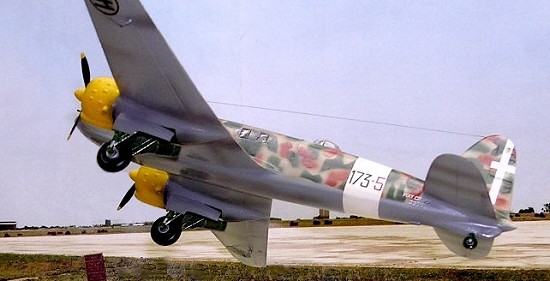 interior floor
decking and separate wheel well doors for those who like me prefer to make
the kit with lowered wheels. There is also a vacform sheet of clear acetate
that contains the nose glazing, cockpit canopy with an integral astrodome,
and a rear gun clear dome.
interior floor
decking and separate wheel well doors for those who like me prefer to make
the kit with lowered wheels. There is also a vacform sheet of clear acetate
that contains the nose glazing, cockpit canopy with an integral astrodome,
and a rear gun clear dome.
The three-page instruction sheet is very comprehensive, clearly printed and easy to follow complete with 4-view drawing. This can be enlarged by 141% to bring scale plans to a scale of 1/72. Also included are drawings to show the style of camouflage pattern that goes with the CR-25 and which invariably differed from other types of camouflage but which you could tell that that the style was associated with aircraft of the Reggia Aeronautica during WWII. In addition to the camouflage "bis" version, there is also a bonus for a different type of CR-25 with an overall silver scheme as used by the Italian Air Attaché in Berlin. The same aircraft could also carry camouflage as it was in fact finished later on in the war. Also there is a quick colour reference chart. The instruction sheet has an exploded view, which shows the interior of the crew compartment and position of the fitting of all the glazed parts.
| CONSTRUCTION |
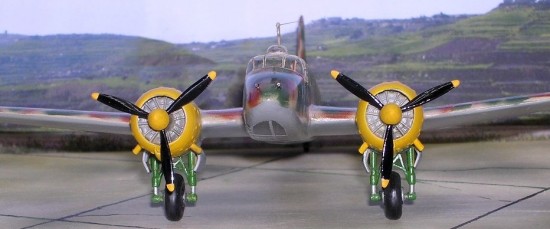 During
the assembly of the two fuselage halves, plastic locating strips as
normally practiced with vacform kits should be added at the joint-line. The
kit can obviously assemble as in flight or with the undercarriage in the
down position. Detailing of the wheel wells may add to the authenticity of
the finished model. Detail of how to achieve this is also suggested in the
accompanying drawings. There is one item which is a DF loop and which I did
not bother to fit in position over the cockpit area for the simple reason
that all the photos that I have seen none seem to have this fitted on them.
I also elected to replace the mast antenna with a sturdier steel needle in
order to attach the wire that goes from top of the aerial to the upper tail
fin leading edge. One
During
the assembly of the two fuselage halves, plastic locating strips as
normally practiced with vacform kits should be added at the joint-line. The
kit can obviously assemble as in flight or with the undercarriage in the
down position. Detailing of the wheel wells may add to the authenticity of
the finished model. Detail of how to achieve this is also suggested in the
accompanying drawings. There is one item which is a DF loop and which I did
not bother to fit in position over the cockpit area for the simple reason
that all the photos that I have seen none seem to have this fitted on them.
I also elected to replace the mast antenna with a sturdier steel needle in
order to attach the wire that goes from top of the aerial to the upper tail
fin leading edge. One
 has
to be careful to separate the detail landing gear from the runner and to
add the additional parts that were missing in the kit that goes with the
undercarriage and are shown in the sketch included in the instructions. All
in all one particular tricky stage is when it comes to fit the clear
acetate parts in order to mar the clear panels, as super glue would be
needed for this part.
has
to be careful to separate the detail landing gear from the runner and to
add the additional parts that were missing in the kit that goes with the
undercarriage and are shown in the sketch included in the instructions. All
in all one particular tricky stage is when it comes to fit the clear
acetate parts in order to mar the clear panels, as super glue would be
needed for this part.
I have
preferred to fit the two front crew figures as it gives the model a scale
and makes a more authentic display. Decal sheet provided is also detailed
and trimming of carrier film is recommended.
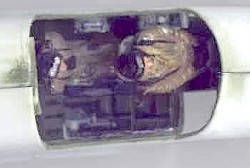 The decal sheet caters for any
of the three CR-25 bis depicted in the instruction sheet but does not cater
for the CR-25 transport version which after all carries the minimum of
decals on it. I have added an extra set of windows to the port fuselage,
which for some unknown reason only one was marked on the vacform fuselage
halves of the kit.
The decal sheet caters for any
of the three CR-25 bis depicted in the instruction sheet but does not cater
for the CR-25 transport version which after all carries the minimum of
decals on it. I have added an extra set of windows to the port fuselage,
which for some unknown reason only one was marked on the vacform fuselage
halves of the kit.
The scale model of the CR-25 can only be obtained from Airmodel products via Matthias Simon, Horsteiner Weg 1, 63500, Soleigenstadt, Germany. Or e-mail: info@airmodel.de (Your editor would like to mention that an injected kit of this aircraft was produced in 2003/4 by Special Hobby)
| CONCLUSIONS |
Careful assembly of the CR-25 bis turns it into an impressive model and Airmodel products must be highly praised for releasing the kit with injection-moulded parts which help a lot to bring this kit not beyond the capability of the average modeller.
January 2005
Carmel J.Attard (Malta)
If you would like your product reviewed fairly and quickly by a site that has nearly 300,000 visitors a month, please contact me or see other details in the Note to Contributors.